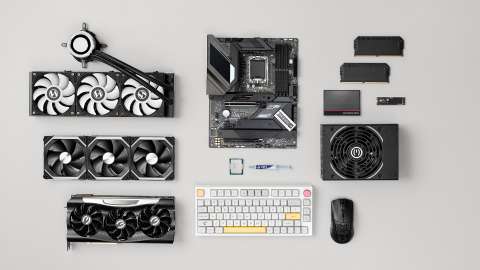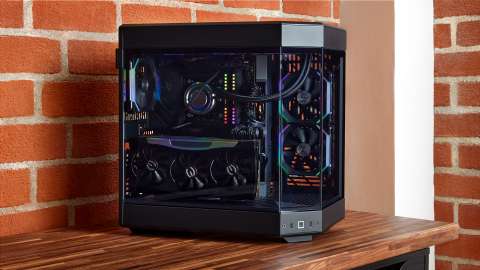What Parts Do You Need to Build a Pc for Gaming: Ultimate Guide
To build a gaming PC, you need a CPU, GPU, RAM, motherboard, storage, power supply, and a case. Don't forget cooling solutions and peripherals.
Building a gaming PC can be a rewarding experience. It allows you to customize your setup for optimal performance and aesthetics. Selecting the right parts is crucial for a smooth gaming experience. The CPU and GPU are the most critical components, as they handle the processing and graphics rendering.
RAM ensures quick access to data, while the motherboard connects all the parts. Storage options, such as SSDs, offer faster load times. The power supply provides necessary electricity, and the case houses everything neatly. Cooling solutions keep temperatures in check, ensuring longevity and performance. Finally, peripherals like a keyboard, mouse, and monitor complete your gaming setup.

Credit: www.reddit.com
Choosing The Right Cpu
Building a gaming PC begins with choosing the right CPU. The CPU, or Central Processing Unit, is the brain of your computer. It handles all the instructions from your computer's hardware and software. To have a smooth gaming experience, a powerful CPU is essential. Let's dive into the details of what you should consider.
Performance Needs
Understanding your performance needs is crucial. Different games have different requirements. High-end games need more powerful CPUs. For casual gaming, a mid-range CPU might suffice. Here are some key points to consider:
- Clock Speed: Measured in GHz, higher speeds mean faster performance.
- Core Count: More cores allow for better multitasking and performance in modern games.
- Thermal Design Power (TDP): Indicates the power consumption and cooling needs.
- Cache: Larger cache sizes can improve performance in certain tasks.
Consider these factors to match your gaming needs.
Popular Models
There are many CPU models on the market. Here are some popular ones for gaming:
| Model | Clock Speed | Cores/Threads | TDP |
|---|---|---|---|
| Intel Core i9-12900K | 3.2 GHz (up to 5.2 GHz) | 16/24 | 125W |
| AMD Ryzen 9 5950X | 3.4 GHz (up to 4.9 GHz) | 16/32 | 105W |
| Intel Core i5-12600K | 3.7 GHz (up to 4.9 GHz) | 10/16 | 125W |
| AMD Ryzen 5 5600X | 3.7 GHz (up to 4.6 GHz) | 6/12 | 65W |
Selecting one of these popular models can ensure a good gaming experience. Each has its own strengths and price points. Choose based on your budget and gaming needs.
Selecting A Gpu
Choosing the right GPU is crucial for a gaming PC. It's the heart of your gaming experience, impacting graphics quality and performance. Let's explore the key aspects of selecting a GPU.
Graphics Quality
The GPU determines how well your games look and run. A powerful GPU delivers better graphics and smoother gameplay. Here are the factors to consider:
- Resolution: Higher resolutions need more GPU power.
- Refresh Rate: Higher refresh rates require better GPUs.
- VR Support: Virtual Reality demands high-end GPUs.
For stunning visuals, choose a GPU that supports the latest technologies. Look for features like ray tracing and DLSS.
Budget Vs. High-end
Your budget will influence your GPU choice. Here’s a comparison:
| Category | Budget GPUs | High-End GPUs |
|---|---|---|
| Price Range | $150 - $300 | $500 - $1500 |
| Performance | Good for 1080p | Excellent for 1440p & 4K |
| Future-Proofing | 1-2 years | 3-5 years |
| Examples | GTX 1660, RX 580 | RTX 3080, RX 6800 XT |
Budget GPUs offer decent performance for casual gamers. High-end GPUs provide superior performance for enthusiasts.
Balance your performance needs and budget to choose the right GPU. Consider second-hand options for high-end models within budget.
Motherboard Essentials
The motherboard is the backbone of your gaming PC. It connects all the components and ensures they work together. Choosing the right motherboard is crucial for optimal performance. Let's explore the essentials you need to consider for your gaming motherboard.
Compatibility
Compatibility is the most important factor in selecting a motherboard. Make sure the motherboard supports your chosen CPU socket type. Common socket types include Intel LGA 1200 and AMD AM4. Check the motherboard's form factor, such as ATX, Micro-ATX, or Mini-ITX. Ensure it fits your PC case. Verify RAM compatibility, including type (DDR4 or DDR5) and maximum capacity.
Here is a compatibility checklist:
- CPU Socket Type
- Form Factor
- RAM Type and Capacity
- GPU Support
- Storage Interface (SATA, NVMe)
Features To Look For
Gaming motherboards come with various features. These enhance your gaming experience. Look for the following features:
- PCIe Slots: Ensure enough slots for your GPU and other expansion cards.
- USB Ports: Multiple USB 3.0 and 3.1 ports for peripherals.
- Networking: Gigabit Ethernet and Wi-Fi support for online gaming.
- Audio: High-quality onboard audio for immersive sound.
- RGB Lighting: Customizable lighting to match your setup.
Some motherboards also offer overclocking support. This can boost your CPU and RAM performance.
Here's a quick feature comparison:
| Feature | Importance |
|---|---|
| PCIe Slots | High |
| USB Ports | Medium |
| Networking | High |
| Audio | Medium |
| RGB Lighting | Low |
Choose a motherboard that balances performance, features, and budget. This ensures a smooth and enjoyable gaming experience.
Memory Matters
Memory is crucial for a gaming PC. It impacts your system's speed. RAM lets your computer handle multiple tasks at once. Good memory ensures smooth gameplay.
Ram Types
There are different RAM types. The most common ones are DDR3 and DDR4. DDR4 is the newer type. It offers better performance. It is faster and uses less power. Most modern motherboards support DDR4. For gaming, always choose DDR4.
Optimal Sizes
The size of RAM you need depends on your gaming needs. For most games, 8GB of RAM is enough. For better performance, 16GB is the sweet spot. It allows for smoother multitasking. Some high-end games may require 32GB. But for most gamers, 16GB is ideal.
| RAM Size | Performance | Recommended For |
|---|---|---|
| 8GB | Basic | Most games |
| 16GB | Optimal | High-end gaming |
| 32GB | High | Professional use |
When building a gaming PC, memory matters a lot. Choose the right RAM type and size. This ensures your games run smoothly.
Storage Solutions
Choosing the right storage solution is crucial for building a gaming PC. Your storage affects game load times, system boot speed, and overall performance. Understanding the differences between SSDs and HDDs, along with capacity considerations, will help you make informed decisions.
Ssd Vs. Hdd
Solid State Drives (SSDs) and Hard Disk Drives (HDDs) serve the same purpose but differ in technology and performance. SSDs use flash memory, leading to faster read and write speeds. This means quicker game load times and faster boot-up. HDDs, on the other hand, use spinning disks and are generally slower but cost less per gigabyte.
- Speed: SSDs are significantly faster than HDDs.
- Durability: SSDs have no moving parts, making them more durable.
- Cost: HDDs are cheaper but slower.
Capacity Considerations
Choosing the right storage capacity depends on your needs and budget. For most gamers, a mix of SSD and HDD offers the best of both worlds. Here are some tips to help you decide:
| Type | Suggested Capacity | Use Case |
|---|---|---|
| SSD | 500GB - 1TB | Operating System, Frequently Played Games |
| HDD | 1TB - 4TB | Media Storage, Backup, Less Frequently Played Games |
For the best performance, install your operating system and favorite games on an SSD. Use an HDD for large files and backup.
Power Supply Unit
The Power Supply Unit (PSU) is the heart of your gaming PC. It provides power to all your components. Choosing the right PSU is critical for system stability and performance.
Wattage Needs
Your PSU's wattage determines how much power it can deliver. Calculate the total wattage of your components. Add a 20% buffer to ensure stability. Here is a simple guide:
| Component | Average Wattage |
|---|---|
| CPU | 95W |
| GPU | 250W |
| Motherboard | 50W |
| RAM | 10W per stick |
| Storage | 10W per drive |
| Fans | 5W per fan |
Efficiency Ratings
PSU efficiency ratings show how well a PSU converts AC to DC power. Look for the 80 PLUS certification. Higher ratings mean better efficiency:
- 80 PLUS: 80% efficiency
- 80 PLUS Bronze: 82% efficiency
- 80 PLUS Silver: 85% efficiency
- 80 PLUS Gold: 87% efficiency
- 80 PLUS Platinum: 90% efficiency
- 80 PLUS Titanium: 92% efficiency
A higher efficiency PSU reduces power waste. It keeps your system cooler and quieter.
Cooling Systems
Building a gaming PC requires efficient cooling systems. The cooling system keeps your components at a safe temperature. This ensures optimal performance. There are two main types of cooling systems: air cooling and liquid cooling. Both have their pros and cons. Let's explore these systems further.
Air Vs. Liquid Cooling
Air cooling uses fans and heatsinks. Fans draw heat away from the components. Heatsinks then disperse this heat into the air. Air cooling is simple to install. It's also more affordable.
Liquid cooling uses a pump to circulate coolant. This coolant absorbs heat from the components. Radiators then release this heat. Liquid cooling is more efficient. It keeps temperatures lower. It's also quieter than air cooling.
| Feature | Air Cooling | Liquid Cooling |
|---|---|---|
| Cost | More Affordable | More Expensive |
| Installation | Simple | Complex |
| Efficiency | Moderate | High |
| Noise | Louder | Quieter |
Noise Levels
The noise level of your cooling system can affect your gaming experience. Air cooling tends to be louder. Fans can produce a noticeable hum. This can be distracting during gameplay.
Liquid cooling is generally quieter. The pump and radiator fans make less noise. This keeps your gaming environment peaceful. If you prefer a silent setup, liquid cooling is a better option.
To minimize noise, consider high-quality fans. Look for fans with low decibel ratings. You can also use sound-dampening materials. These materials reduce the noise from your cooling system.

Credit: www.intel.com
Case Selection
Choosing the right case is vital for building a gaming PC. It impacts both performance and aesthetics. The case you select will house all your components, so choose wisely.
Size And Form Factor
The size and form factor of a PC case determine what components it can hold. Cases come in various sizes: Full Tower, Mid Tower, and Mini Tower.
- Full Tower: Ideal for extensive cooling systems and multiple graphics cards.
- Mid Tower: Most popular, balancing size and component compatibility.
- Mini Tower: Compact, suitable for smaller setups and limited space.
Consider your motherboard type when choosing a case:
| Form Factor | Compatibility |
|---|---|
| ATX | Fits Full and Mid Tower cases |
| Micro-ATX | Fits Mid and Mini Tower cases |
| Mini-ITX | Fits Mini Tower cases |
Aesthetic Choices
The case also defines the look of your gaming PC. Options range from sleek minimalistic designs to flashy RGB setups.
Consider these aesthetic elements:
- Color: Choose a color that matches your setup or theme.
- Material: Cases come in metal, plastic, and glass. Each offers a unique look.
- RGB Lighting: Add personality with customizable lighting.
Some gamers prefer cases with tempered glass panels to showcase their build. Others may opt for cases with soundproofing features to reduce noise. The choice is yours, but remember to balance style with functionality.
Peripheral Devices
Peripheral devices are crucial for a complete gaming experience. These include monitors, keyboards, and mice. These devices enhance your interaction with the game and the PC.
Monitors
Monitors play a vital role in gaming. The right monitor improves visual performance. Here are some factors to consider:
- Resolution: Higher resolution offers clearer images. Aim for at least 1080p.
- Refresh Rate: A higher refresh rate gives smoother visuals. Look for 144Hz or more.
- Response Time: Lower response time reduces lag. Aim for 1ms or 2ms.
- Size: Larger screens enhance the visual experience. Popular sizes range from 24 to 32 inches.
| Feature | Recommendation |
|---|---|
| Resolution | 1920x1080 (Full HD) or higher |
| Refresh Rate | 144Hz or more |
| Response Time | 1ms - 2ms |
| Size | 24 inches - 32 inches |
Keyboards And Mice
A good keyboard and mouse set boosts gaming performance. They also offer comfort during long gaming sessions.
- Mechanical Keyboards: Preferred by gamers for their tactile feedback and durability.
- RGB Lighting: Adds style and helps in low-light conditions.
- Programmable Keys: Customizable keys for quick actions in games.
- Mouse DPI: High DPI settings allow for precise movements. Look for mice with adjustable DPI settings.
| Feature | Recommendation |
|---|---|
| Keyboard Type | Mechanical |
| Lighting | RGB |
| Programmable Keys | Yes |
| Mouse DPI | Adjustable, 800 - 16000 DPI |

Credit: www.intel.com
Building And Assembly
Building a gaming PC is an exciting project. It requires careful planning and execution. Below, we'll guide you through the process. Ensure you avoid common mistakes and enjoy the assembly.
Step-by-step Guide
-
Gather Your Parts
Before starting, ensure you have all parts. This includes the CPU, GPU, motherboard, RAM, storage, power supply, and case.
-
Prepare Your Workspace
Ensure your workspace is clean and static-free. Have all tools ready, such as a screwdriver.
-
Install the CPU
Place the CPU gently into the motherboard socket. Lock it in place carefully.
-
Install the RAM
Insert the RAM sticks into the motherboard slots. Ensure they click firmly.
-
Mount the Motherboard
Secure the motherboard inside the case using screws. Align it properly.
-
Install the GPU
Insert the GPU into the PCIe slot on the motherboard. Screw it in securely.
-
Connect Storage
Attach SSD or HDD to the case. Connect to the motherboard with cables.
-
Power Supply Installation
Secure the power supply in the case. Connect cables to all components.
-
Final Checks
Ensure all components are connected. Check for loose cables or screws.
-
Power On
Turn on the PC and enter the BIOS. Ensure all parts are detected.
Common Mistakes
-
Using Excessive Force
Don't force components into place. They should fit easily.
-
Ignoring Static Precautions
Always ground yourself to avoid static damage to parts.
-
Incorrect Cable Management
Ensure cables are tidy. This improves airflow and prevents overheating.
-
Skipping BIOS Updates
Update your BIOS to ensure compatibility with new components.
-
Overlooking Compatibility
Check that all parts are compatible with each other.
Frequently Asked Questions
What Part Do You Need To Build A Gaming Pc?
To build a gaming PC, you need a CPU, GPU, motherboard, RAM, storage, power supply, case, and cooling system.
What Is Required In Pc For Gaming?
A gaming PC needs a powerful CPU, high-end GPU, 16GB RAM, SSD storage, and a reliable power supply.
What Pc Parts Are Recommended For Gaming?
For gaming, choose a high-end GPU, a fast multi-core CPU, 16GB RAM, SSD storage, and a quality PSU.
What Is The First Thing To Buy When Building A Pc?
The first thing to buy when building a PC is the motherboard. It determines compatible components like CPU and RAM.
Conclusion
Building a gaming PC requires careful selection of each component. Choose quality parts for the best performance. Ensure compatibility between your CPU, GPU, motherboard, and other components. Don’t forget essential peripherals like a monitor, keyboard, and mouse. With the right parts, you’ll enjoy an unparalleled gaming experience.
Happy building!

No comments